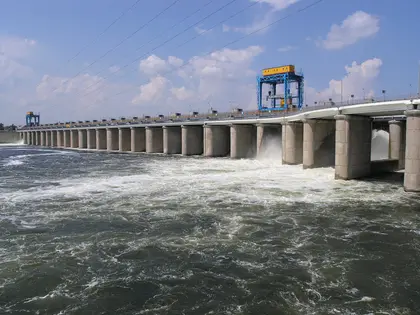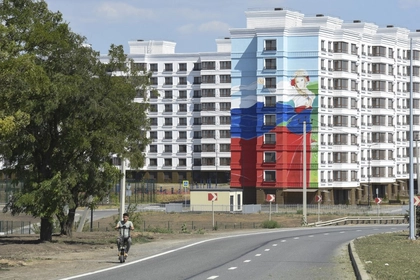As Ukraine grapples with a myriad of environmental challenges, one issue has become the center of debate due to its complexity and the polarized views it has generated: the question of whether the Kakhovka hydroelectric power plant (HPP) should be rebuilt.
Once a vital source of water and energy, the Kakhovka HPP now stands in ruins after its destruction. The debate revolves around two different points of view – the state, farmers, and energy companies, on the one hand, advocate for rebuilding the HPP, and ecologists, on the other hand, push for the restoration of the natural and historical landscape of the Velykyi Luh.
JOIN US ON TELEGRAM
Follow our coverage of the war on the @Kyivpost_official.
In this column, I want to delve into these two perspectives, analyzing in detail all the arguments that ecologists, government officials, and farmers put forward. I do not intend to take sides in this debate. Instead, I want to offer readers a balanced view of the situation, enabling them to form opinions based on presented information.
In Favor: The Energy perspective
On July 18, 2023, the government adopted a resolution on a pilot project to start rebuilding the Kakhovka HPP, reconstruct it after its destruction, and ensure the stable operation of the Dnipro HPP during this reconstruction. It consists of two stages.
Government officials and farmers emphasize that the destruction of the Kakhovka HPP wreaked havoc on the nation's economy and the environment of the surrounding regions. As a result, the irrigation systems of 5,800 square kilometers (3,600 square miles) of agricultural land were left without water supply, disrupting the production of about two million tons of grain per year. Industrial enterprises in the regions also suffer from water shortages. The country has lost 335 MW of renewable electricity capacity. In addition, the full resumption of the Zaporizhzhia nuclear power plant (NPP) operation after the plant de-occupation is impossible without the Kakhovka reservoir restoration.

IMF Approves $1.1 Billion Loan Disbursement to Ukraine Before Trump Inauguration
The project’s first stage involves the design and construction of specific structures necessary for the stable operation of the Dnipro HPP during further restoration work at the Kakhovka HPP. The second stage involves the design and work directly on the de-occupied territory.
Power engineers emphasize that the importance of the Kakhovka HPP goes beyond energy production. It is crucial for covering the water shortage in Kherson, Zaporizhzhia, and Dnipro regions, which depended on supplies from the Kakhovka reservoir. The HPP also fed the irrigation system and supplied water to the Zaporizhzhia NPP. It also ensured the Dnipro River’s navigation, whose depth has significantly dwindled now.
The Kakhovka HPP plays a vital role in balancing green energy. Mykolaiv, Kherson, partly Dnipro, and Zaporizhzhia regions have the most sunny days in Ukraine and are the windiest areas, making them ideal for green energy development. However, wind and solar power plant production is poorly predictable and must be balanced with traditional generation sources like thermal or hydroelectric power plants.
The absence of the Kakhovka HPP has impacted the efficiency of the entire Dnipro cascade of power plants. Currently, the Dnipro HPP is operating with restrictions due to insufficient water levels.
The project’s second stage proposes the construction of a temporary dam at the Kakhovka HPP site after the plant de-occupation. This hydraulic structure will get the reservoir restoration started.
According to farmers, if the hydroelectric power plant is not restored, the territory of the former Kakhovka reservoir will not return to its natural state but will turn into a wetland, posing additional environmental challenges.
Thus, supporters of the restoration of the Kakhovka HPP emphasize that it is not only about energy production, but also about water supply, green energy balance, and environmental degradation prevention.
AGAINST: The Environmental perspective
The Ukrainian Environmental Protection Group, an NGO established in 2014, presents an opposing position to the government's position on the Kakhovka HPP rebuilding. They argue that it would be more socially, environmentally, and economically beneficial for Ukraine to revive the Velykyi Luh, a natural and historical landscape.
The Velykyi Luh, once a flourishing natural area, was flooded by the waters of the Kakhovka Reservoir in 1955-1958. The destruction of the Kakhovka hydroelectric power plant by Russia in 2023 led to the disappearance of the reservoir, putting Ukraine in front of a historic choice: to rebuild the HPP or revive the Velykyi Luh.
Ecologists argue that the revival of the Velykyi Luh is in line with the EU Biodiversity Strategy for 2030: Bringing Nature Back into Our Lives, developed by the European Commission. This strategy stipulates that by 2030, half of European territories should become protected areas (30 percent) and be restored to their natural state (20 percent). As Ukraine moves towards the EU, meeting these targets becomes critical, and the restoration of the Velykyi Luh can serve as a model project.
Reviving this natural area harmonizes with both environmental and public concerns. The site of the Kakhovka Reservoir was once the largest natural forest in the steppe zone of Ukraine. Its regeneration holds the potential to fulfill government objectives for expanding forested areas. The return of natural ecosystems over such a large area could have many positive environmental outcomes.
Ecologists also deny the economic feasibility of restoring the HPP. They emphasize that no EU country will finance and implement such an inappropriate environmental project. The costs required for its implementation seem unjustifiable compared to the needs that can be met exclusively by a reservoir. Experts have analyzed that drinking water supply and irrigation, which raised the most questions in the first months after the destruction, can be restored soon without the need to reconstruct the HPP.
The only point that cannot be directly compensated in the absence of reservoir restoration is the electricity generated by the HPP. However, ecology experts emphasize that the role of the Kakhovka HPP as an energy unit held no decisive weight for the state.
Thus, supporters of the Velykyi Luh regeneration assert that it is not just about preserving natural ecosystems, it is also about meeting European biodiversity goals, benefiting the environment and the population, and making economically rational decisions.
The debate over the Kakhovka HPP reconstruction is a complex and multifaceted issue, with convincing arguments on both sides. The impending decision will undoubtedly have far-reaching consequences for Ukraine's environment, economy, and energy sector.
On the one hand, the government, farmers, and energy industry advocate for the Kakhovka HPP reconstruction, emphasizing its pivotal role in supplying water to farmland and industrial enterprises, balancing green energy, and preventing environmental degradation.
Ecologists, on the other hand, propose an alternative way which is to regenerate the Velykyi Luh, a natural and historical landscape once flooded by the waters of the Kakhovka reservoir.
Both perspectives emphasize the complexity of this matter. The decision to rebuild the Kakhovka HPP or regenerate the Velykyi Luh is not simply a matter of choosing between energy production and environmental preservation. It involves a comprehensive assessment of many factors like economic feasibility, compliance with the European biodiversity targets, and potential benefits for both the environment and the population.
Moving ahead, it is crucial to continue this dialog, taking into account all perspectives and available information. The impending decision will both shape Ukraine's energy landscape and mold its environmental future. This decision requires thorough consideration, comprehensive analysis, and a balanced assessment of all potential consequences and benefits.
You can also highlight the text and press Ctrl + Enter






